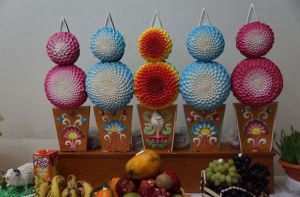Tibetan Butter Sculpture
The art of making sculptures out of butter has been practiced for over 400 years by monks in the monasteries in Tibet. This highly revered artistic tradition is now being preserved by monks and nuns in living in India as refugees.
Butter sculptures can be huge and impressive or tiny and intricate. They are used as offerings or as part of elaborate rituals and celebrations, particularly during Losar, Tibetan New Year.
It is the practice in Buddhism to offer flowers as a tribute to Buddha statues on altars. However, in winter when no fresh flowers can be found, flowers sculpted from butter are made as an offering.
Butter has always been highly valued in Tibetan culture. Its availability and its malleable quality in the cold climate of the Tibetan plateau and the Himalayas made it an ideal material for sculpting.
Making butter sculptures requires painstaking skill, learned from an excellent teacher and through years of practice. Like the famous Tibetan sand mandalas, butter sculptures are a unique Tibetan sacred art that is handed down from teacher to student.
The increasing shortage of well-trained and skilled butter sculptors in Tibet means that it is crucial that in India the nuns learn this religious art as part of their course of studies in order to keep it from dying out.
At Dolma Ling Nunnery and Institute in India, nuns have been learning how to make butter sculptures from their excellent teacher Gen. Karma-la. He carefully takes them through all the steps and the significance of each butter sculpture technique. He says the nuns make excellent students, with their keen sense of color and design, their nimble fingers, and their endless patience.
The Need for a Butter Sculpture Workshop
Creating butter sculptures in the hot climate of India is, as you can imagine, problematic. The workshop room must be cool and have access to cold water in which to lay the butter and cool the nuns’ fingers.
Until now, the nuns at Dolma Ling Nunnery have been using a makeshift space at the nunnery that gets very hot. They are only able to make sculptures during the very coldest months. Now a suitable space has been located in the nunnery that, with renovations, will be ideal.
The Tibetan Nuns Project is raising funds to help create a butter sculpture workshop at Dolma Ling Nunnery. The total cost of the project is US $2,500, but at the time of posting this blog $500 dollars had been raised, so only $2,000 is needed to fully fund the workshop.
Source
[[1]]
